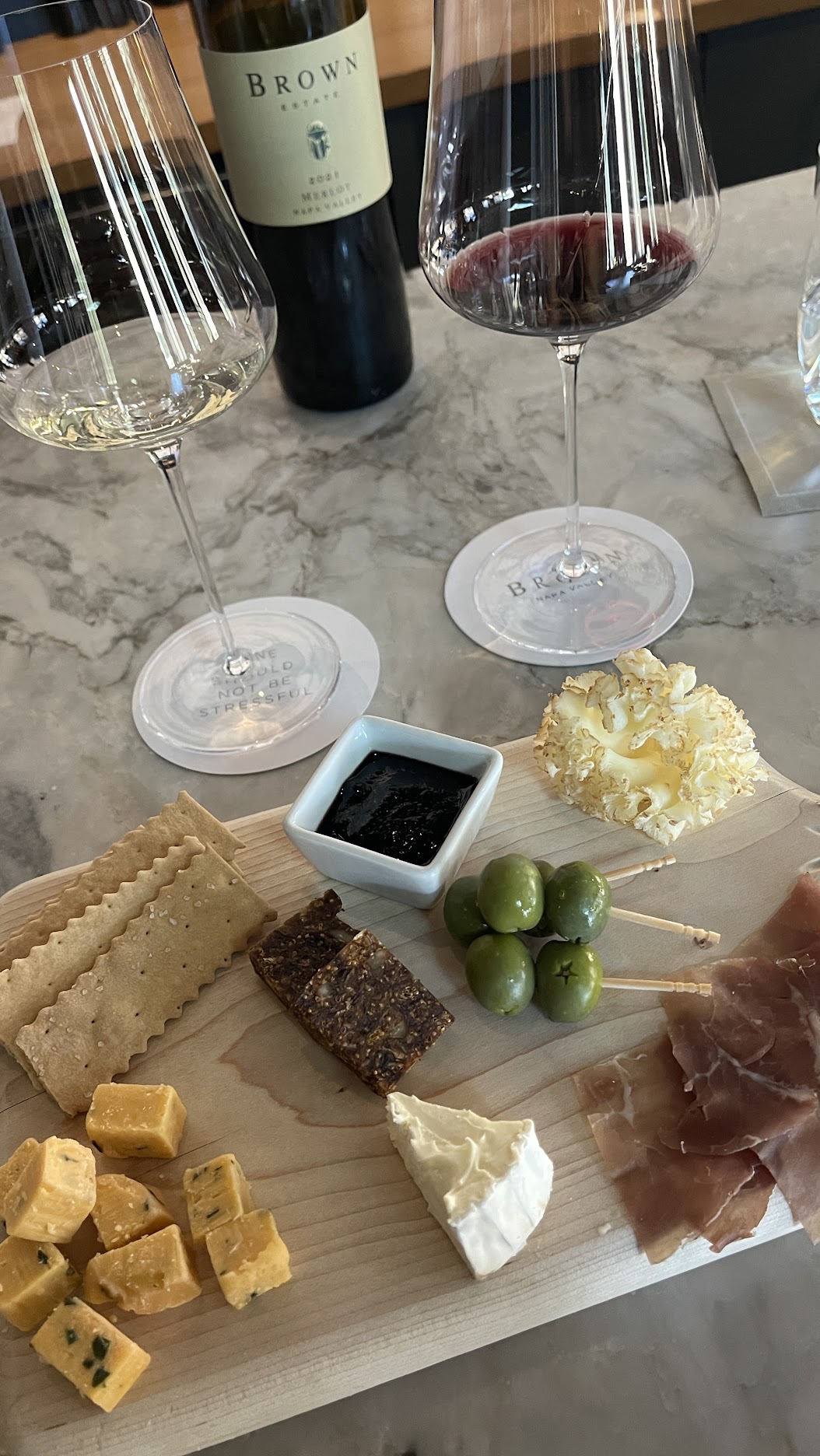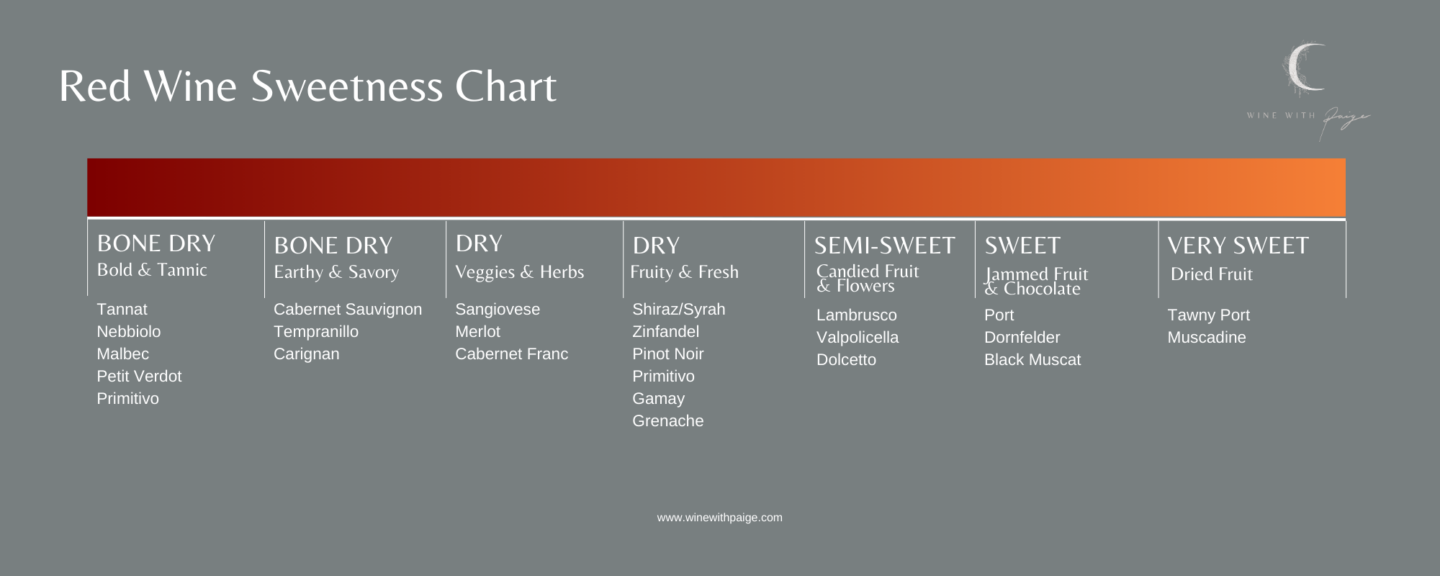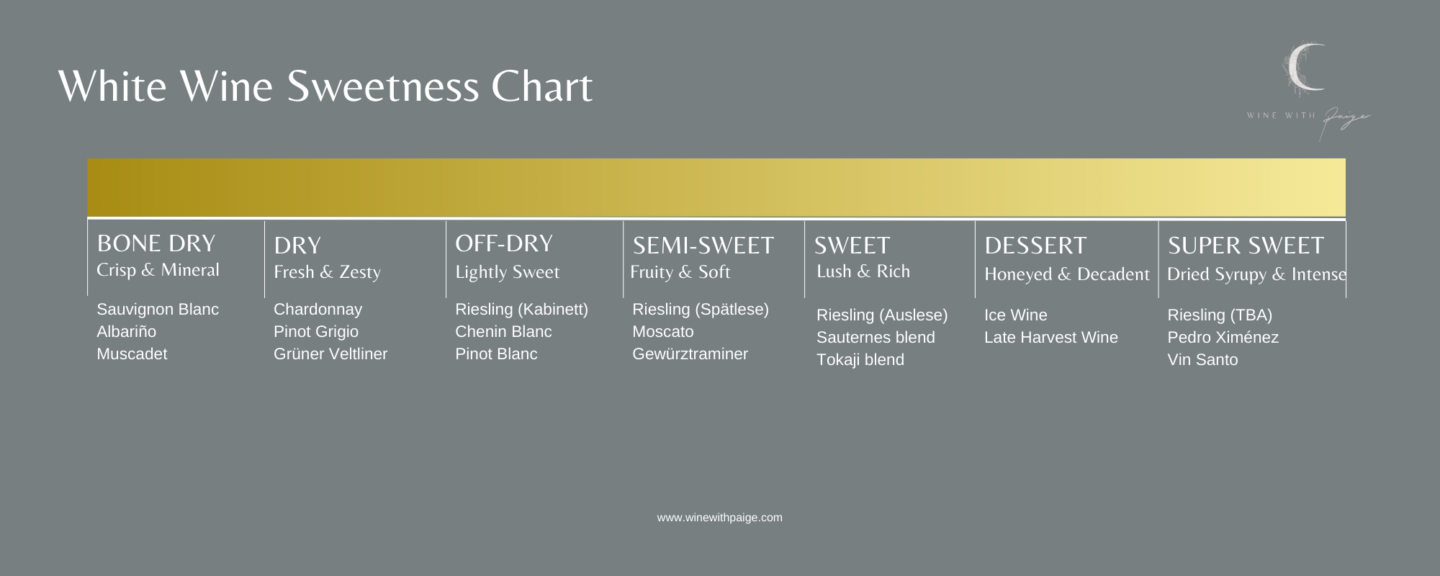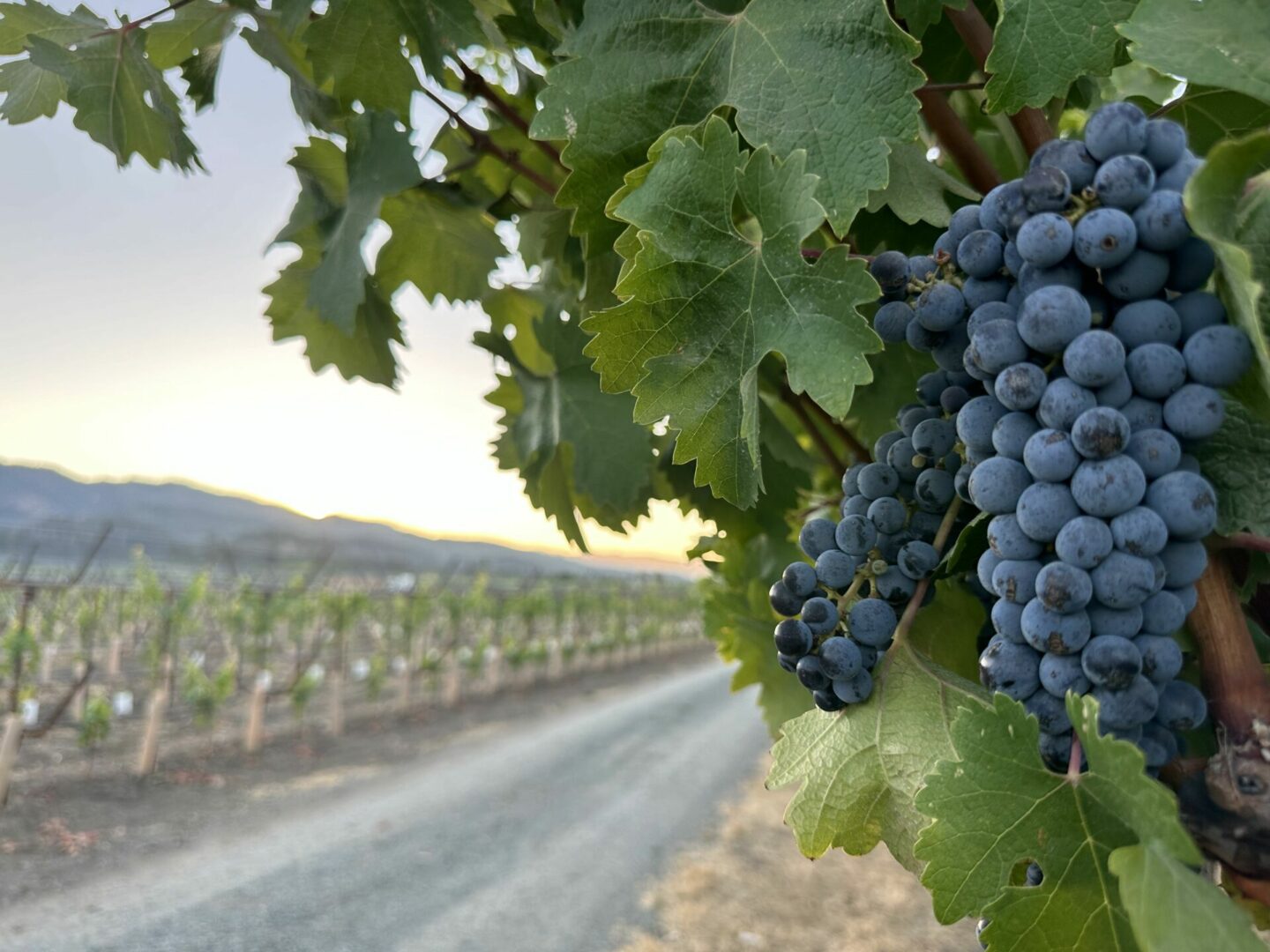
Ever find yourself staring at a wine list, unsure which one to pick because the sweetness levels can be so confusing? You’re not alone. Knowing how sweet or dry a wine is can make all the difference in your enjoyment.
Luckily, tools like a wine sweetness chart and wine sweetness scale can help take the guesswork out of your decision. These charts break down wines into categories based on their sweetness, giving you a clear idea of what to expect before you take that first sip.
Sweetness in wine isn’t just about sugar; it’s about balance, acidity, and how these elements come together to create a wine’s unique taste. Understanding where your favorite wines fall on the sweetness scale can enhance your wine experience.
This handy guide to wine sweetness will help make your wine selection process a little less daunting and a lot more enjoyable.
What is Wine Sweetness?
Wine sweetness refers to how sweet a wine tastes, and this is determined by the amount of residual sugar left in the wine after fermentation. During fermentation, yeast converts the sugars in grape juice into alcohol, but sometimes not all the sugar gets converted.
The leftover sugar, known as residual sugar, is what gives the wine its sweetness. The more residual sugar, the sweeter the wine will be, ranging from bone-dry wines with almost no sugar to dessert wines that are very sweet.

Importance of Sweetness
Sweetness levels in wine are crucial because they greatly influence how the wine tastes and how it pairs with food. A sweeter wine can balance out spicy or salty dishes, while a drier wine might be better suited to rich, fatty foods. Sweetness also affects the overall balance of a wine, contributing to its complexity and the way it is perceived on the palate.
Overview of Wine Sweetness Scale
A wine sweetness scale is a guide that helps wine enthusiasts understand how sweet or dry a wine is likely to taste. There are two kinds: the red wine sweetness chart, which shows the sweetness level of red wines, and the white wine sweetness chart for white wines.

Red Wine Sweetness Scale
This is structured into different levels, ranging from bone dry to very sweet, each level indicating the amount of residual sugar left in the wine after fermentation. Here’s a breakdown of each level:
- Bone Dry (Bold and Tannic): These wines are completely dry with almost no residual sugar, making them taste bold, with a strong tannic presence. Examples: Malbec, Nebbiolo.
- Bone Dry (Earthy and Savory): Similar to the bold and tannic wines but with a focus on earthy and savory flavors rather than tannins. Examples: Cabernet Sauvignon, Tempranillo.
- Dry (Veggies and Herbs): These wines have minimal sweetness and often display vegetal or herbal notes. Examples: Red wines like Merlot, Cabernet Franc.
- Dry (Fruity and Fresh): Still dry but with a fresh, fruity profile that makes the wine feel lighter on the palate. Examples: Pinot Noir, Grenache.
- Semi-Sweet (Candied Fruits and Flowers): Wines in this category have a noticeable dash of sweetness, often with flavors reminiscent of candied fruits and floral notes. Examples: Dolcetto, Lambrusco.
- Sweet (Jammed Fruit and Chocolate): These sweet red wines are rich and sweet, with flavors that evoke jammed fruits and sometimes a hint of chocolate. Examples: Port, Black Muscat.
- Very Sweet (Dried Fruit): At the sweetest end of the scale, these wines are intensely sweet, often with flavors of dried fruits like raisins or figs. Examples: High alcohol content wines like Tawny Port, Muscadine.
Related: Sweet Red Wines You’ll Love!

White Wine Sweetness Chart
The white wine sweetness scale or chart is a tool that helps you understand how sweet or dry a white wine will taste. This chart is structured into seven levels, ranging from bone dry to super sweet, with each level indicating the amount of residual sugar in the wine and the resulting flavor profile.
- Bone Dry (Crisp and Mineral): These wines have little to no residual sugar, making them taste very dry, with a focus on crisp acidity and a mineral character. They often feel sharp and refreshing. Examples: Sauvignon Blanc, Muscadet.
- Dry (Fresh and Zesty): Wines at this level are still dry but with a zesty, fresh taste. They may have more pronounced fruit flavors than bone-dry wines but remain without noticeable sweetness. Examples: Sparkling wines like Chardonnay, Pinot Grigio.
- Off-Dry (Lightly Sweet): These wines have a slight sweetness that balances their acidity, offering a hint of sugar without being overwhelmingly sweet. The sweetness is subtle and often pairs well with spicy foods. Examples: Chenin Blanc, Pinot Blanc.
- Semi-Sweet (Fruity and Soft): Wines in this category are distinctly sweet, but not dessert-level sweet. They have soft, fruity flavors that are more pronounced, making them easy to enjoy on their own or with lighter desserts.
Examples: Gewürztraminer, Moscato. - Sweet (Lush and Rich): These wines are sweet and rich, often with a lush, full-bodied texture. They typically feature ripe fruit flavors and are great for pairing with desserts or enjoying as a sweet treat on their own.
Examples: Sauternes blend, Tokaji blend. - Dessert (Honeyed and Decadent): Dessert wines are very sweet, often with honeyed flavors and a decadent, syrupy texture. They are typically enjoyed with or as a dessert and can have flavors ranging from tropical fruits to caramel and toffee.
Examples: Ice Wine, Late Harvest Riesling, - Super Sweet (Syrupy and Intense): These wines are the sweetest on the chart, with intense syrupy flavors that are rich and concentrated. They are often sipped slowly and are perfect for ending a meal on a sweet note.
Examples: Pedro Ximénez, Vin Santo.
Related: The Best Sweet White Wines
Understanding a Wine Sweetness Chart
Reading a wine sweetness chart can make choosing the right wine much easier, especially if you’re trying to match your taste preferences or pair a wine with food. Here’s how to read and interpret a wine sweetness chart:
- Understand the Scale: The chart is typically organized from the driest wines on the left to the sweetest on the right. Dry wines have little to no residual sugar, while sweet wines contain more residual sugar, giving them a sweeter taste. Levels might be labeled as Bone Dry, Dry, Off-Dry, Semi-Sweet, Sweet, and Dessert or Super Sweet.
- Match Your Taste: Determine where your taste preference lies on the chart. If you prefer wines that are crisp and not sweet, look for those labeled as Bone Dry or Dry. If you enjoy a touch of sweetness, Off-Dry or Semi-Sweet wines might be more your style. For a truly sweet experience, look for wines in the Sweet or Dessert categories.
- Consider Food Pairing: Use the chart to help select wines that will pair well with the meal you’re planning. For example, Dry wines often complement savory dishes, while Sweet wines might be better suited to desserts or spicy foods.
- Pay Attention to the Labels: When you’re at the store, compare the wine’s description on the label to the categories on the chart. This can help ensure you’re choosing a wine that fits your preferred sweetness level.

Factors Influencing Wine Sweetness
Grape Varieties
The type of grape used in winemaking plays a crucial role in determining the wine’s sweetness. Some grape varieties naturally have higher sugar content, leading to sweeter wines.
For example, grapes like Riesling and Moscato are known for producing sweet wines due to their high natural sugar levels. In contrast, grapes like Chardonnay and Sauvignon Blanc typically produce drier wines that taste less sweet because they contain less residual sugar after fermentation.
Winemaking Techniques
Winemakers can control a wine’s sweetness through different methods. One common technique is stopping fermentation early, which leaves more residual sugar in the wine, making it taste sweeter.
Another technique is chaptalization, where sugar is added before fermentation to increase alcohol content, sometimes resulting in a sweeter wine.
Geographical Influence
The climate and region where grapes are grown also impact a wine’s sweetness. In warmer climates, grapes tend to accumulate more sugar as they ripen, leading to wines with higher sweetness potential and fruitier aromas and flavors.
For instance, wines from warmer regions like California or Australia might be naturally sweeter than those from cooler climates. France or Germany may have grapes that don’t develop as much sugar during ripening. This geographical influence helps shape the overall flavor profile and sweetness of the wine
Using the Wine Sweetness Chart to Choose the Right Wine
Pairing with Food: When it comes to pairing wine with food, the wine sweetness scale can be a game-changer. For instance, a bone-dry wine, like a crisp Sauvignon Blanc, pairs wonderfully with light dishes like salads or seafood. This is because it doesn’t overpower the food’s delicate flavors.
On the other hand, a semi-sweet wine like an off-dry Riesling can balance out the spiciness in Asian or Indian cuisine. This gives a refreshing contrast. If you’re serving dessert, a sweet wine like a Sauternes or a late-harvest Muscat is perfect. In this instance, it complements the rich and sugary flavors of the dish.
The key is to match the wine’s sweetness with the intensity of the flavors in your food, creating a harmonious dining experience.
Personal Preferences: Beyond food pairing, the wine sweetness chart is a great tool for discovering wines that match your personal taste. If you prefer wines that are not too sweet but still have a hint of fruitiness, you might enjoy a semi-sweet or off-dry wine like a Gewürztraminer.
If you’re a fan of rich, luscious flavors, exploring dessert wines or those labeled as ‘sweet’ on the chart could lead you to your new favorite bottle.
Common Myths About Wine Sweetness
Myth 1: All Sweet Wines Are Dessert Wine
One of the biggest misconceptions is that sweet wines are only meant for dessert. While it’s true that many dessert wines are sweet, not all sweet wines fall into this category.
Wines like Riesling or Moscato can range from off-dry to sweet and are often enjoyed with meals or on their own, not just with dessert. Sweet wines can be versatile and pair well with spicy foods, cheeses, and even savory dishes, proving they’re not just for dessert.
Myth 2: Dry Wines Are Always Better
Another common belief is that dry wines are superior to sweet wines. This isn’t true at all; it’s a matter of personal preference.
Dry wines, like Cabernet Sauvignon or Pinot Grigio, can be fantastic, but so can sweet wines like Port or Lambrusco. Sweetness in wine doesn’t make it lesser; it simply offers a different tasting experience.
The better wine is the one you enjoy, whether it’s dry, sweet, or somewhere in between.
Myth 3: Sweet Wines Are Low-Quality
Some people think that sweet wines are cheap or of lower quality, but that’s far from the truth. Many sweet wines, like Sauternes from France or Ice Wine from Canada, are crafted with incredible skill and are highly regarded. The sweetness in these wines comes from the natural sugars in the grapes, often achieved through labor-intensive methods like late harvesting or noble rot. These wines can be just as complex and high-quality as their dry counterparts.
Myth 4: Sweet Wines Are Only for Beginners
It’s often said that sweet wines are for people who are new to wine, but experienced wine lovers also appreciate them.
The range of flavors in sweet wines—from the delicate sweetness of a Moscato to the intense richness of a Vin Santo—can appeal to any wine enthusiast. Sweet wines offer a unique tasting experience that can be enjoyed by both novices and connoisseurs alike.
Conclusion
Understanding wine sweetness with charts and scales is essential for making informed wine choices. Knowing a wine sweetness chart and scale makes it easier to find wines that fit your taste and the occasion.
Whether you’re pairing wine with food or just sipping it on its own, these tools make the choice simpler and more fun. So, explore different wines using a sweetness chart, discover new favorites, and share your experiences with others.
Let these charts and scales be your guide as you explore all that wine has to offer.Cheers!
